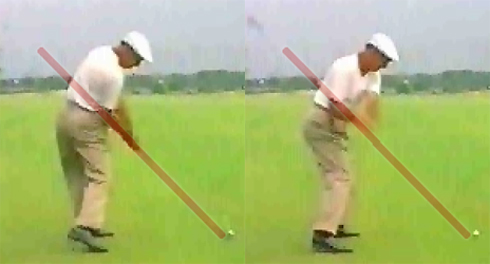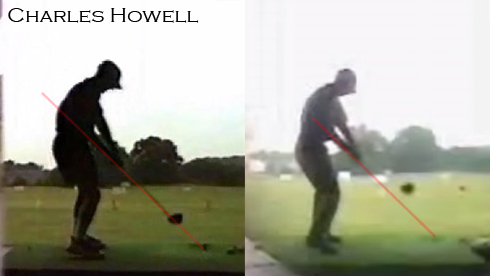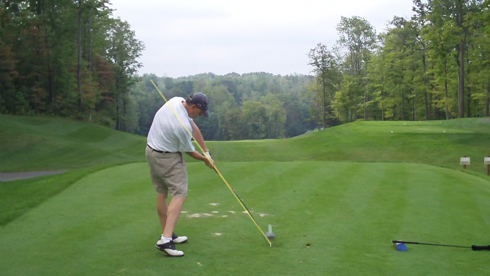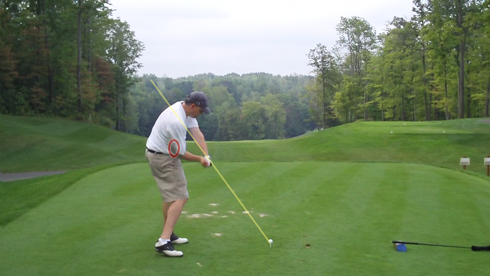 Dave Koster is very different than many of the players we analyzed in previous articles. Dave hits the ball 290 yards with a slight draw. He plays scratch golf. He has won his club championship. Simply stated, Dave Koster is not a beginner. The catch is that like all of us – including Tiger – as he can definitely improve.
Dave Koster is very different than many of the players we analyzed in previous articles. Dave hits the ball 290 yards with a slight draw. He plays scratch golf. He has won his club championship. Simply stated, Dave Koster is not a beginner. The catch is that like all of us – including Tiger – as he can definitely improve.
Identifying problems in Dave’s swing is not very hard. However, given the fact that several of his problems are clearly offsetting each other, our challenge will be to identify what problem is holding him back from going even lower.
Read on to see Dave’s swing and the fixes I’ve outlined for him.
The Swing
Dave’s swing can be seen here as a QuickTime movie. This shows the down-the-line and face-on angles with his driver. I would highly recommend that you to watch the video, identify what you think is his root problem, and then read on.
Beginner v. Scratch Golfer
There are obvious differences between a beginner and a scratch golfer. In my mind, beginners have very little “grooved” into their swing and are considerably more malleable. What is perhaps more important is that a major swing change does not effect a beginner as much because they only have so far that they can fall. However, scratch golfers and pros are very different. After thousands of golf balls, scratch golfers have developed a swing which they can rely on. Their muscles have been so ingrained with their swing that any little change can devastate their game. And by devastate, I unfortunately do not mean that they go from shooting 73 to 75; I mean that they could go from breaking 70 to struggling to break 90.
So the first question that we need to ask ourselves is what are the goals of this golfer. Dave plays a 15-yard draw with his driver and is not hoping to end up hitting the ball dead straight but instead to become a little more consistent and to eliminate his tendency to snap hook the ball. He is not looking for more distance.
Given his wishes, my first thought is to look at the parts of his swing that directly relate to accuracy. Just as review, those would be: 1) ball position, 2) club face, 3) leading shoulder, and 4) swing plane. If all four of those are perfect then he should be hitting the ball like the Ping Man. Unfortunately for Dave, they are not all perfect.
Swing Plane
People make swing plane much more complicated than it has to be. Swing plane is the optimal path that your club should take to hit the ball. To figure out what your plane line should be all you need to do is draw a line through your shaft at impact.

Thus, if your club follows this line during your down swing, you are on plane. If your club is over or under this line, you are off plane.

Dave’s Swing Plane
For the sake of simplicity, let’s start at Dave’s impact position and work backwards to find out what is the root of his swing plane problem.
Impact

As you can see above, this is a picture of Dave at impact. The line that is drawn through Dave’s shaft is Dave’s plane line. Ideally, Dave would trace this line during his down swing.
Arm Horizontal

It may be somewhat hard to see but Dave’s shaft is close to horizontal to the ground. At this point in the swing Dave should absolutely be on plane. However, Dave is clearly inside of his plane line meaning that he is off plane.
Top of the Swing

I don’t even have to draw line 4 to tell you that Dave is crossing at the top. When you cross at the top of your swing your hands have to make a significant adjustment coming down to have any chance of hitting a good shot. Many high handicap players don’t make any adjustment which causes them to come straight over the top and hit a terrible slice. On the other hand, low handicappers tend to error on the side of over-adjusting. By dropping his hands too far from this position, Dave has ended up under his plane line.
Fortunately, Dave is not going to lose nearly as much distance coming under plane because it will result in a strong draw. Moreover, a draw is significantly more predictable so he can still play very high caliber golf. However, when your timing of this move is just a little off, it can easily result in a block or a hook. If you are planning on a 15 yard draw with your driver and end up blocking the ball right or hooking the ball left, you could easily be off by 30 or more yards from your target. If Dave wishes to improve, I would highly recommend fixing the top of his swing so he can get on plane.
Potential Fixes
You may notice other things in Dave’s swing which you believe are not correct. If you did, I would respectfully remind you that we are doing more of a tune up than a rebuild of his swing. Our goal is to find a swing thought that Dave can take to the range and work with over the next week to two weeks. Here’s what I would suggest.
Video Camera
I would highly recommend that Dave bring a video camera with him for his practice sessions. I am going to suggest a couple of different feels for him to try in an effort to fix the top of his swing but he needs to be able to monitor which feel is working for him. After all, practice does not make perfect; perfect practice makes perfect.
Pointing the Shaft
One of the easiest ways for a player to feel the proper position at the top of their swing is to focus on where the shaft is pointed at the top of the swing. If you look at the top of Dave’s swing, he is currently pointing the club to the right of the target. Ideally, Dave should be pointing the club either dead down his target line OR just to the left of his target. I would probably suggest he start by trying to point down the target line. If that doesn’t work, then he should gradually try to point the club farther and farther left of his target until he starts to see results.
Pointing the Grip
While some golfers find pointing the shaft easy, others have a hard time thinking about where their shaft is at the top of their swing. A different approach to take is to focus on where the butt of the club is pointed. As you can see, Dave has the butt of his club pointed towards the bottom left corner of the screen. Ideally, the butt of the club would be pointed either straight back at the camera or to the bottom right corner of the screen. I would often set up my golf bag at a point where I was hoping to point the club just so I could have something to aim at.
Other
These two thoughts primarily use your hands to adjust the top of your swing but there are numerous other ways to approach this as well. Whether it is trying to tuck your right elbow closer to your body or trying to focus on keeping your left wrist flat at the top of the swing, you need to find the swing thought that works best for you.
Time Line: Correcting the top of your swing can be extremely frustrating if you do not monitor with a video camera. If you do, then this can be a problem that can take around two weeks of solid practice to fix. If you don’t use video though, don’t be surprised if this takes months to ingrain in your swing.
Be sure to monitor… Your swing plane. Seems obvious enough but if you are a player that is already making a strong drop with your hands before you accelerate then you are actually going to want to continue making that exact same move once you achieve the proper position at the top of your swing. If you don’t then all you are going to do is teach yourself to come over the top.
Conclusion
Dave already has already achieved so much. However, whether you are a professional golfer or a duffer, achieving proper swing plane should be one of your top priorities. If Dave can get himself on plane I wouldn’t be surprised if we hear that he has abandoned his 15 yard draw and replaced it with a longer, straighter drive.
Your Turn!
If you’re interested in having your swing analyzed in a future edition of Swing Check here on The Sand Trap, check out the requirements page and submit your videos today!

Dave,
As a person who has spent many hours fighting the battle of breaking par… and breaking it often I might add, I have come to a conclusion. The only person holding you back from playing on tour is you. You control how much you practice and you control what demons influence your mental game… therefore it is only you who can “help you get better.”
Dont go out and get lesson after lesson. Dont get a swing/mental coach. Dont think for one second that you need someone or something to tell you your swing is flawed. Guess what, everybody has swing flaws. O’Connel means well with his analysis, but you already have the tools. My guess is, if your good enough to win your club championship then you already have what it takes.
I spent gobs of money on lessons and still shot the same scores. I could quit for 2 weeks and still shoot 2 over. The fact is, when you get to the level of shooting par and a few rounds under here and there, the “fight” inside you is the only thing that needs working on. Look at Earnie Els, thats a mental mess traped inside big body. Its not fun anymore for him. Instead of Butch Harmon changing his entire swing, he needs to go back in time when he was 19 and play with reckless abandonment.
Who cares if you’re “off plane” and “crossing at the top”, so is Jim Furyk. Play like a kid does Dave, with fight, with grit, with the love of this stupid game in your eyes. It will allow that much needed third element to take over… good old fashion luck.
Not to be picky but Jim Fuyrk is on plane. He swing different but he is on plane.
The two things I first notice is him getting too over the top on the backswing. He’d stay on plane if he kept it alittle flatter at the top, would also help him keep his left arm a bit straighter and not fight it so much on the way down with that pull hook or block. Also looks off balance a bit, lifts his front heel and then falls back on it… that might be happening so that he can make room for the deep elbow drop he has to make to stay inside (since he’s a bit over the top) and not slice it.
I’m not a golf pro, just a lowly 8 capper but that’s what I see that I think would get him to a more sound swing. Then again, what do I know…
I made the mistake once of having bought six lessons after the instructor was done with me I was so screwed up and depressed I almost quit.
after giving it a break for two months, I went back out to the range and starting hitting balls until they did what I wanted them to do.
I agree with scotty2hotty , get yourself wraped up in all the teck stuff and golf becomes work and not fun.
Ray
Um, with respect, I think you guys are missing the point of this column. It’s fine if you’re not interested in discussing the technical aspects of a golf swing, or if you think it’s not worthwhile; as I understand it, though, this column is devoted to swing analysis. It’s right there in the title.
For what it’s worth, my own view is that paying attention to technique does pay off in the mid to long term. It’s difficult to be at all consistent if your swing isn’t in the ballpark of being technically correct. (Obviously, Dave, your swing is in that ballpark!)
I couldn’t have said it better myself! Paralysis by Analysis has killed many of golf swings. You have a very solid swing. However, I noticed you hung back a little on your follow through, but again solid swing!
A couple of points and then I’ll be quiet (I think).
1. I strongly debated with myself and others about whether to address the motion of Dave’s body throughout the swing. My basic argument went something like this. The way Dave’s body is moving COULD lead to him going over the top, coming under, or any number of other flaws. However, making a change with the motion of your body is a huge undertaking and, as I said above, I wanted to give Dave a tune-up and not a total overhaul. Could his body improve? Absolutely. If he wanted to face a potential set back for a few months, that would probably have been where I went with the analysis. Ultimately, I feel that it would make him a better player but he could suffer for a good while first. What I was hoping for was something that would directly affect his accuracy in the short term as well as be something he could build on long term. So for those of you seeing his motion with his body, I agree, but I just didn’t want to toy with his swing THAT much.
2. Dave is obviously a good player. Winning a club championship, shooting below par, etc. is extremely hard to do. However, as many low handicappers know, you will often hit a wall where you just can’t go much further with the swing you have. There is a reason why even the self taught golfers on tour seek out a teacher to help them make those “final” changes that will push them over the top; see Y.E. Yang. So while the people above say that he should just stick with what he has, consider that Dave wants to improve beyond where he has reached so far.
Hope that clears up what I was thinking.
I would tend to disagree, or at least disagree in some or maybe even most cases. I think it depends on the change being made. For example, I had a swing flaw very similar to one of Dave’s, it involved my body, and I started seeing improvements immediately – improvements in distance, ball-striking, and consistency of ball flight.
I’d fix two things in Dave’s swing.
The first is the length of his backswing. His shoulders stop turning and he doesn’t gain any more coil when his club is just past vertical, yet he lifts his arms and adds the hinge to the wrists late in his swing. The arm lift, I believe, is particularly destructive as it requires even better timing coming down because you can’t just pivot, but rather you have to drop and pivot.
The second, more of a body move, is the over-the-top move that sometimes haunts Dave and causes the pull-hooks. That’s a far more serious problem than the blocks, which he can typically play. I think Dave’s lower body stops going forward prematurely. When the hips stop pushing forward they start to rotate, and when the hips rotate the shoulders soon follow. Rotate early and the right shoulder kicks out over the top too early. Tiger and Ben Hogan both had/have aggressive hip pushes forward through to impact. In the video, Dave’s hip stops pushing forward when his club returns to vertical and his arms are just past horizontal on the downswing.
Proof of the lack of hip push through the ball is seen by how much weight remains on his back foot at the end of his swing – a lot.
Both of my points are illustrated in this image (in reverse order – hip one at the top, end of shoulder turn below).
I think that thinking about the path during the swing is the opposite way to approach the golf swing for most people. The swing path and the planes of the golf swing occur because of other actions. For example, Dave is pretty close to being on a perfect plane right up until his shoulders stop coiling. It’s the “raise the hands up” move and the late cocking of the wrists that get him ever so slightly across the line and above the plane.
Now, I’m not claiming to be a master swing guru or even a plus handicap golfer, but these are things I’ve fixed in my own swing and seen the results, and I believe they’re things which Dave could fix too.
Dave here. Here are my comments.
The biggest thing I’ve fought in my swing over the past few years is something that Erik has picked up on. It’s the lack of a good, full shoulder turn. When I focus on that and push that left shoulder well under my chin I usually hit pretty crisp and hard shots. When I don’t I hit the over-the-top lazy hooks. It’s something I’ve had difficulty repeating in my swing. What I didn’t realize is how much MORE guys like Tiger and Ernie (looking at vids on youtube) turn their shoulders. It’s at least a good 15-20 degrees more.
To TM’s point, the reason I’m a like that at the top of the swing is that I’ve tried getting a bit more steep to get a higher launch on my driver and other clubs. I might have been fixing it in the wrong way though. One thing I noticed when I saw these videos a week or so ago was that my grip was REALLY strong (look at the start of the swings in the vids). I haven’t changed it in a while but it’s something I need to do long-term to hit the ball more consistently. I’ve tinkered with it and had some success. The irons are much better but the driver/woods off the tee are still a struggle. I hit balls yesterday and seemed to work even those out.
I’ll worry about the body more later. One thing at a time, right? 🙂
Kudos to Dave for being brave enough to open his swing for critique.
My question might be obvious, but by working from impact backwards, am I making a correct assumption that Dave’s impact position is good? I mean it looks good to me.
If it hadn’t been, would the analysis be different?
“To figure out what your plane line should be all you need to do is draw a line through your shaft at impact”
What if your impact position is off?
I thought you were supposed to draw a line thru your shaft at address?
Just wondering cause I am about to film my swing, again.
Nope. Common misconception. You actually draw your plane line through your shaft at impact. Hogan’s plane line is very close to his set up but many, if not most, players will have a plane line that is higher than their set up. See Tiger, Mickelson, Scott, Howell, Nicklaus, and others. Nice question though.
Dave has an awesome swing for an amateur. I would recommend your article on the new ball flight laws because a pull and pull hook are clubface angle problems according to Trackman and that article. Dave 99% of all golfers can only watch your swing in envy-appreciate your gift